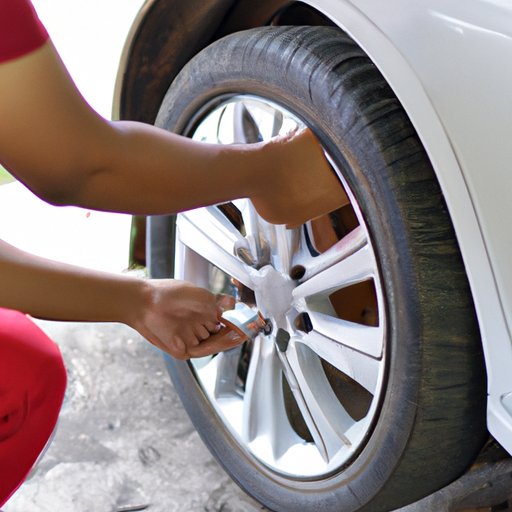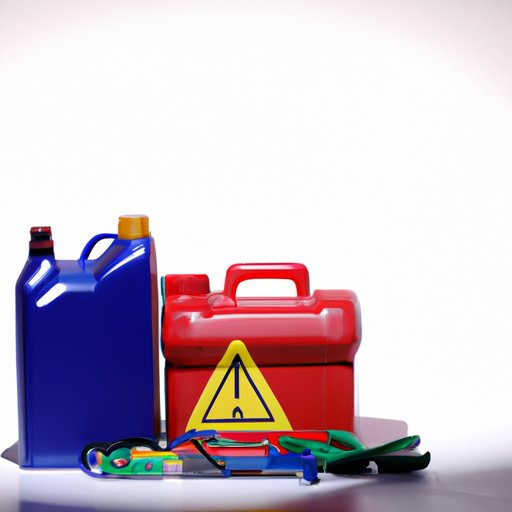Introduction
Travelling by car is a great way to get around, but before you begin your journey it is important to make sure your vehicle is in good condition. Taking the time to inspect and test different parts of your car before travelling will help ensure a safe and comfortable trip. In this article, we will provide an overview of what to check before travelling by car.
Check the Vehicle’s Fluids
One of the first things to check before travelling by car is the vehicle’s fluids. This includes the engine oil, brake fluid, power steering fluid, and coolant levels. It is important to check these fluids because they are essential to keeping your car running smoothly.
Checking Engine Oil
The engine oil helps keep your car’s engine lubricated and running properly. To check the engine oil, pop open the hood and locate the dipstick. Pull the dipstick out and wipe it off with a clean rag. Reinsert the dipstick and pull it out again. The oil should be between the two lines indicated on the dipstick. If the oil is low, add more until it is at the correct level.
Checking Brake Fluid
Brake fluid is also important for keeping your car running smoothly. To check the brake fluid, look for the reservoir under the hood. Make sure the fluid is between the minimum and maximum lines indicated on the reservoir. If the fluid is low, top it up with the appropriate type of brake fluid.
Checking Power Steering Fluid
Power steering fluid helps your car turn and steer easily. To check the power steering fluid, locate the reservoir and make sure the fluid is between the minimum and maximum lines indicated. If the fluid is low, top it up with the appropriate type of power steering fluid.
Checking Coolant Levels
Coolant helps keep your car’s engine from overheating. To check the coolant levels, locate the reservoir and make sure the fluid is between the minimum and maximum lines indicated. If the fluid is low, top it up with the appropriate type of coolant.
Inspect the Tires
Another important thing to check before travelling by car is the tires. It is important to check the tire pressure, tread depth, and for any signs of damage or wear. This will help ensure that your tires are in good condition and will not fail while you are driving.
Checking Tire Pressure
The tire pressure should be checked regularly to ensure that your tires are properly inflated. To check the tire pressure, use a tire pressure gauge to measure the pressure in each tire. The recommended pressure can usually be found on the sidewall of the tire or in the owner’s manual. If the pressure is too low, use an air compressor to inflate the tires to the recommended pressure.
Checking Tread Depth
The tread depth is important for providing traction when driving. To check the tread depth, use a tread depth gauge to measure the depth in each tire. The recommended depth can usually be found on the sidewall of the tire or in the owner’s manual. If the tread depth is too low, it is time to replace the tires.
Checking for Signs of Damage or Wear
It is also important to check the tires for any signs of damage or wear. Look for bulges, cracks, or cuts in the sidewalls. Also check for uneven wear, which could indicate that the alignment is off or that the tires need to be rotated. If you notice any of these issues, it is best to have the tires inspected by a professional.
Test All Lights
Another important thing to check before travelling by car is the lights. All of the lights should be tested to make sure they are working properly. This includes the headlights, brake lights, turn signals, and backup lights.
Headlights
The headlights are important for visibility when driving at night. To test the headlights, turn them on and make sure both bulbs are working. If one of the bulbs is not working, it may need to be replaced.
Brake Lights
The brake lights are important for alerting other drivers when you are slowing down or stopping. To test the brake lights, press the brake pedal and make sure both bulbs are working. If one of the bulbs is not working, it may need to be replaced.
Turn Signals
The turn signals are important for alerting other drivers when you are turning. To test the turn signals, press the turn signal lever and make sure both bulbs are working. If one of the bulbs is not working, it may need to be replaced.
Backup Lights
The backup lights are important for visibility when reversing. To test the backup lights, put the car in reverse and make sure both bulbs are working. If one of the bulbs is not working, it may need to be replaced.

Make Sure Your Spare Tire is in Good Condition
Another important thing to check before travelling by car is the spare tire. It is important to make sure the spare tire is in good condition in case you get a flat tire while driving. To check the spare tire, inspect it for any signs of damage or wear and make sure the tire pressure and tread depth are within the manufacturer’s recommendations.
Checking the Tire’s Pressure
To check the tire pressure, use a tire pressure gauge to measure the pressure in the spare tire. The recommended pressure can usually be found on the sidewall of the tire or in the owner’s manual. If the pressure is too low, use an air compressor to inflate the tire to the recommended pressure.
Checking the Tire’s Tread Depth
To check the tread depth, use a tread depth gauge to measure the depth in the spare tire. The recommended depth can usually be found on the sidewall of the tire or in the owner’s manual. If the tread depth is too low, it is time to replace the spare tire.
Checking for Any Signs of Damage
It is also important to check the spare tire for any signs of damage or wear. Look for bulges, cracks, or cuts in the sidewalls. If you notice any of these issues, it is best to have the tire inspected by a professional.
Check the Brakes
The brakes are another important part of your car that should be checked before travelling. It is important to check the brake pads, brake lines, and the master cylinder. If you notice any problems with the brakes, it is best to have them inspected and repaired by a professional.
Checking Brake Pads
The brake pads help stop the car when you press the brake pedal. To check the brake pads, look for any signs of wear or damage. If the pads are worn, they may need to be replaced.
Checking Brake Lines
The brake lines are responsible for transferring brake fluid from the master cylinder to the brakes. To check the brake lines, look for any signs of leaks or damage. If the lines are leaking, they may need to be repaired or replaced.
Checking the Master Cylinder
The master cylinder is responsible for storing and transferring brake fluid to the brakes. To check the master cylinder, look for any signs of leaks or damage. If the master cylinder is leaking, it may need to be repaired or replaced.
Ensure You Have a Roadside Emergency Kit
Finally, it is important to make sure you have a roadside emergency kit in your car. This kit should include items such as a flashlight, jumper cables, flares, a first aid kit, and other essential items. The emergency kit should be stored in the car so it is easily accessible in case of an emergency.
Items to Include in an Emergency Kit
Some items that should be included in an emergency kit are a flashlight, jumper cables, flares, a first aid kit, emergency contact numbers, a toolkit, and a spare tire. Other items that may be useful to have in an emergency kit are a fire extinguisher, a tow rope, a blanket, water, and snacks.
Storing the Emergency Kit in the Car
The emergency kit should be stored in the car so it is easily accessible in case of an emergency. The best place to store the emergency kit is in the trunk or back seat of the car. This will ensure that the emergency kit is within reach if it is needed.
Conclusion
In conclusion, there are many things to check before travelling by car. This includes checking the vehicle’s fluids, inspecting the tires, testing all lights, making sure your spare tire is in good condition, checking the brakes, and ensuring you have a roadside emergency kit. Taking the time to check these things will help ensure a safe and comfortable journey.
(Note: Is this article not meeting your expectations? Do you have knowledge or insights to share? Unlock new opportunities and expand your reach by joining our authors team. Click Registration to join us and share your expertise with our readers.)
